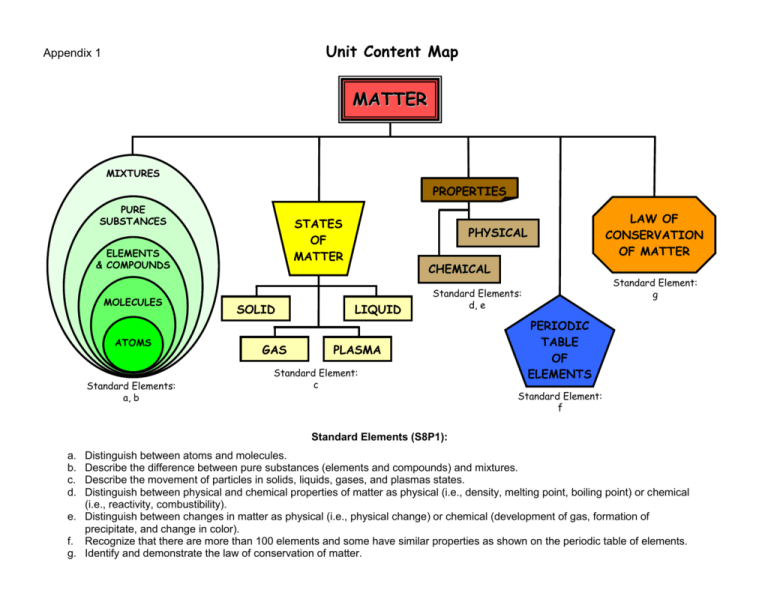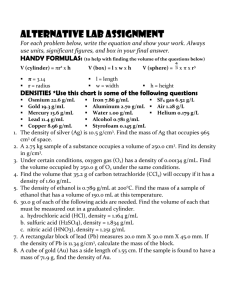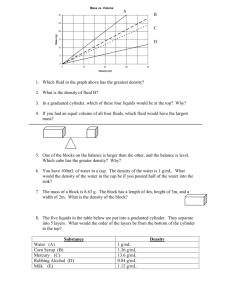
Unit Content Map
Appendix 1
MATTER
MIXTURES
PROPERTIES
PURE
SUBSTANCES
STATES
OF
MATTER
ELEMENTS
& COMPOUNDS
MOLECULES
ATOMS
Standard Elements:
a, b
SOLID
GAS
LAW OF
CONSERVATION
OF MATTER
PHYSICAL
CHEMICAL
LIQUID
Standard Element:
g
Standard Elements:
d, e
PLASMA
Standard Element:
c
PERIODIC
TABLE
OF
ELEMENTS
Standard Element:
f
Standard Elements (S8P1):
a.
b.
c.
d.
Distinguish between atoms and molecules.
Describe the difference between pure substances (elements and compounds) and mixtures.
Describe the movement of particles in solids, liquids, gases, and plasmas states.
Distinguish between physical and chemical properties of matter as physical (i.e., density, melting point, boiling point) or chemical
(i.e., reactivity, combustibility).
e. Distinguish between changes in matter as physical (i.e., physical change) or chemical (development of gas, formation of
precipitate, and change in color).
f. Recognize that there are more than 100 elements and some have similar properties as shown on the periodic table of elements.
g. Identify and demonstrate the law of conservation of matter.
Appendix 2
LEARNING CHANNEL PREFERENCE CHECKLIST
Read each sentence carefully and think about how it applies to you. On each line, write the number that best
describes your reaction to each sentence.
5-ALMOST ALWAYS
1.
2.
3.
4.
5.
6.
7.
8.
9.
10.
11.
12.
13.
14.
15.
16.
17.
18.
19.
20.
21.
22.
23.
24.
25.
26.
27.
28.
29.
30.
31.
32.
33.
34.
35.
36.
4-OFTEN
3-SOMETIMES
2-RARELY
1-ALMOST NEVER
I can remember something better if I write it down.
When reading, I listen to the words in my head or I read aloud.
I need to discuss things to understand them better.
I don’t like to read or listen to directions; I’d rather just start doing.
I am able to visualize pictures in my head.
I can study better when music is playing.
I need frequent breaks while studying.
I think better when I have the freedom to move around; studying at a desk is not for me.
I take lots of notes on what I read and hear.
It helps me to LOOK at a person speaking. It keeps me focused.
It’s hard for me to understand what a person is saying when there is background noise.
I prefer having someone tell me how to do something rather than having to read the directions myself.
I prefer hearing a lecture or tape rather than reading a textbook.
When I can’t think of a specific word, I use my hands a lot and call something a “what-cha-ma-call-it” or a
“thing-a-ma-jig.”
I can easily follow a speaker even though my head is down or I’m staring out the window.
It’s easier for me to get work done in a quiet place.
It’s easy for me to understand maps, charts, and graphs.
When beginning an article or book, I prefer to take a peek at the ending.
I remember what people say better than what they look like.
I remember things better if I study aloud with someone.
I take notes, but never go back and read them.
When I am concentrating on reading or writing, the radio bothers me.
It’s hard for me to picture things in my head.
I find it helpful to talk myself through my homework assignments.
My notebook and desk may look messy, but I know where things are.
When taking a test, I can “see” the textbook page and the correct answer on it.
I cannot remember a joke long enough to tell it later.
When learning something new, I prefer to listen to information on it, read about it, then do it.
I like to complete one task before starting another.
I use my fingers to count and I move my lips when I read.
I dislike proofreading my work.
When I am trying to remember something new, for example, a telephone number, it helps me to form a
picture of it in my head.
For extra credit, I prefer to do a report on tape rather than write it.
I daydream in class.
For extra credit, I’d rather create a project than write a report.
When I get a great idea, I must write it down right away or I’ll forget it.
Lynn O’Brien, 1990 All Rights Reserved / Specific Diagnostic Studies, 11600 Nebel St., Suite 130, Rockville, MD 20852
Appendix 3
Name ___________________________________________
Date ______________
Class __________
Scoring the LCPC
CAREFULLY write the score for each statement on the appropriate line:
1. _______
2. _______
4. _______
5. _______
3. _______
6. _______
9. _______
12. _______
7. _______
10. _______
13. _______
8. _______
11. _______
15. _______
14. _______
16. _______
19. _______
18. _______
17. _______
20. _______
21. _______
22. _______
23. _______
25. _______
26. _______
24. _______
30. _______
27. _______
28. _______
31. _______
32. _______
29. _______
34. _______
36. _______
33. _______
35. _______
_______
_______
_______
Visual Total
Auditory Total
Haptic Total
Sketch in your profile:
Visual Total
__________
Auditory Total
__________
Visual
Haptic Total
__________
Auditory ________ %
TOTAL
(all categories)
__________
Haptic
________ %
________ %
Convert each category to a percent:
Visual
=
visual score
x 100 =
_________ %
x 100 =
_________ %
x 100 =
_________ %
total score
Auditory =
auditory score
total score
Haptic
=
haptic score
total score
Lynn O’Brien, 1990 All Rights Reserved / Specific Diagnostic Studies, 11600 Nebel St., Suite 130, Rockville, MD 20852
Appendix 4
Name__________________________________________________________
Date ___________________
Class _________________
FRAYER MODEL
Definition
Characteristics
Definition
Characteristics
Examples
Non-Examples
Examples
Non-Examples
Definition
Characteristics
Definition
Characteristics
Examples
Non-Examples
Examples
Non-Examples
Appendix 5
DENSITY LAB
D = mass
volume
1.
WOOD BLOCK:
a. Measure the dimensions of the wood block in cm.
b. Calculate the volume of the wood block:
V = length x width x height
c. Weigh the wood block in grams.
d. Calculate the density by using the formula above
(unit: g/cm3)
2.
SPONGE:
Repeat procedure above.
3.
ROCK:
Since we cannot measure the dimensions of a rock, we determine
the volume by immersing it in water.
a. Weigh the rock in grams.
b. Measure 300 mL of water in large graduated cylinder (initial
volume).
c. Immerse rock in cylinder.
d. Read final volume.
e. Subtract initial volume from final volume.
f.
Calculate the density using the formula.
(unit: g/mL)
4.
LIQUID:
Each group has a different liquid.
a. Weigh the empty graduated cylinder (small)
b. Pour 25 mL of liquid into cylinder (this is the volume)
c. Weigh full cylinder.
d. Subtract the weight of empty cylinder from full cylinder (this
is the liquid mass)
e. Calculate the density by using the formula
(unit: g/mL)
Appendix 6
Name __________________________________________
Date ______________
DENSITY LAB
This lab will help you learn how to determine the density of different objects.
D=
mass
volume
g
cm3
or
g
mL
Mass of object: Weigh on triple beam balance in grams.
Volume of regular shaped objects: V = Length (cm) x Width (cm) x Height (cm)
Volume of irregular shaped objects:
Measure a set volume of water in graduated cylinder. Record initial volume (Vi) in mL.
Immerse object in water. Record final volume (Vf) in mL.
Volume of object = Vf (mL) – Vi (mL)
1.
WOOD BLOCK
Mass = _______________ g
Volume = ___________________cm3
D = ______________
Length =
______________ cm
Width =
______________ cm
Height =
______________ cm
D = _____________
2.
SPONGE
Mass = _______________ g
Volume = ___________________cm3
D = ______________
Length =
______________ cm
Width =
______________ cm
Height =
______________ cm
D = _____________
3.
g
cm3
ROCK
Mass = _______________ g
Volume = ___________________ mL
D = ______________
V (initial) = ______________ mL
D = _____________
4.
g
cm3
g
mL
V (final) =
______________ mL
V (rock) = _______ – _______
LIQUID ___________________________
Mass of Liquid = _________________ g
Volume of Liquid = ___________ mL
Mass empty cylinder = ______________ g
D = ______________
Mass full cylinder = ________________ g
Mass of Liquid = _______ – _______ (full – empty)
D = _____________
g
mL
My name is____________________________________
Appendix 7
This is
PERSONAL
INVENTORY
My address is __________________________________
ME!
_____________________________________________
My phone number is ______________________________
My birthday is on _______________________________
My family is made up of ______________________________________________________________
________________________________________________________________________________
My biggest role model is _____________________________________________________________
The most important person in my life is __________________________________________________
During my free time, I like to _________________________________________________________
My favorite television show is _________________________________________________________
The very best movie that I have ever seen is ______________________________________________
I am very good at __________________________________________________________________
I am not so good at _________________________________________________________________
I would like to learn about ____________________________________________________________
I get really angry when ______________________________________________________________
________________________________________________________________________________
The thing that makes me happiest is ____________________________________________________
Things that frustrate me ____________________________________________________________
________________________________________________________________________________
Things that I dislike in other people _____________________________________________________
If I could only change the way I _______________________________________________________
If I was allowed to help in class I would __________________________________________________
My feelings about school _____________________________________________________________
________________________________________________________________________________
I always learn best if _______________________________________________________________
I find it difficult to learn when ________________________________________________________
When others criticize my school work I __________________________________________________
________________________________________________________________________________
My favorite subjects ________________________________________________________________
The subjects I don’t like _____________________________________________________________
I read: rarely
sometimes
often
all the time
There is something else I would like to tell you about me _____________________________________
________________________________________________________________________________
Appendix 8
Commercial Critique Form
Element: _____________________________
Group: _______________________________ and ________________________________
1. Does the commercial contain all the required information for this task? If not, what is
missing?
_________________________________________________________________________
_________________________________________________________________________
_________________________________________________________________________
2.
In your opinion was the commercial “catchy”?
_________________________________________________________________________
3.
Describe the good points of this group’s advertisement (if any).
_________________________________________________________________________
_________________________________________________________________________
_________________________________________________________________________
_________________________________________________________________________
_________________________________________________________________________
4.
Describe the not-so-good points of this group’s advertisement (if any).
_________________________________________________________________________
_________________________________________________________________________
_________________________________________________________________________
_________________________________________________________________________
_________________________________________________________________________
5.
What suggestions would you give this group in order to make their commercial better?
_________________________________________________________________________
_________________________________________________________________________
_________________________________________________________________________
_________________________________________________________________________
Reviewed by ___________________________ and ________________________________
Appendix 9
Mass Conservation Lab
Part I: PROVING THE LAW OF CONSERVATION OF MATTER:
Experiment #1:
1.
Obtain a sheet of notebook paper.
2.
Weigh the sheet of paper using a balance. Record the mass.
3.
Tear the sheet of paper in several small pieces (do not trash the pieces).
4.
Collect all pieces and weigh them using the same balance. Record the mass.
5.
Compare both masses before and after tearing the paper.
6.
What type of change occurred above, physical or chemical? Explain.
Experiment #2:
1.
Place 5 g (1 tsp) of baking soda into a sealable plastic bag.
2.
Place 5 mL (1 tsp) of vinegar into a plastic film canister. Close the lid.
3.
Use a balance to determine the masses of the bag with baking soda and the canister with
vinegar, and record both values in your lab journal.
4.
Place the canister into the bag. Squeeze the air out of the bag, and tightly seal it.
5.
Open the canister in the bag. Mix the vinegar with the baking soda.
6.
When the reaction has stopped measure the total mass of the bag and its contents.
7.
Compare the mass of the materials before and after the reaction.
8.
What type of change occurred above, physical or chemical? Explain.
9.
Explain how both experiments prove the law of conservation of matter.
Experiment #1
Experiment #2
Initial Mass (g)
Final Mass (g)
Change in Mass (g)
PART II: DESIGNING YOUR OWN EXPERIMENT:
Design an experiment to demonstrate the law of conservation of mass using a seltzer tablet and
flask. Be specific in your procedures so another person or group can reproduce your investigation
and gather the same data and observations. Write the procedure first and then conduct your
investigation. Ask your teacher for any additional items you may need for your investigation
(balloons, plastic bags) to create a closed system. Be sure to collect data and observations during
each trial. If you change your procedure along the way, make adjustments to your procedures on
paper.
Appendix 10
Name __________________________________
Date _____________
Class ______
Name __________________________________
Name __________________________________
EXPERIMENT DESIGN RUBRIC
Scientific Accuracy
Reasoning
Communication
Collaboration
Possible
Points
4
Measurements and
answers are very
accurate.
Investigation was
very well designed
and implemented.
Team discussed
ideas completely and
fully answered all
questions with clear
and concise answers.
Team members
worked very
effectively to design
their experiment.
Measurements and
answers are
accurate.
Investigation was
well designed and
implemented.
Team discussed
ideas and fully
answered most
questions with clear
and concise answers.
Team members
worked effectively
to design their
experiment.
Measurements and
answers are fairly
accurate.
Investigation was
adequately designed
and implemented.
Team discussed
some ideas and fully
answered some
questions with clear
and concise answers.
Team members
worked in an average
way to design their
experiment.
Measurements and
answers are not
accurate.
Investigation was
poorly designed and
implemented.
Team discussed few
ideas completely and
fully answered few
questions with clear
and concise answers.
Team members
worked poorly to
design their
experiment.
________
points
________
points
________
points
________
points
Excellent
3
Good
2
Fair
1
Poor
Total
_______
Comments: ________________________________________________________________
_________________________________________________________________________
_________________________________________________________________________
_________________________________________________________________________
_________________________________________________________________________
_________________________________________________________________________
Grade by _________________________________________________________________








